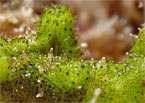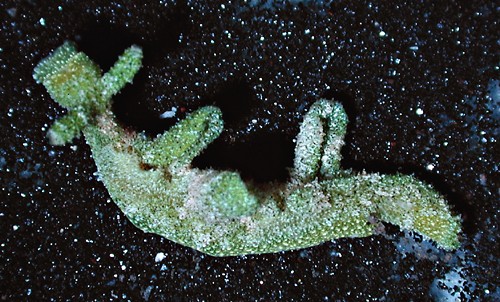| Home |
| Acknowledgments |
| Conventions |
| Glossary |
| Maps |
| References |
| Links |
| Articles |
| Thumbnails |
| Species
list |
| Family |
| Next
species |
Additional Photos

side

texture

young

Elysia sp. #5

| Maximum size: 23 mm. Identification: This is an intensely green animal with white patches and minute, dark green ocelli. The rhinophores are stout and the parapodia form three narrow, tall chimneys with inrolled margins. There are no marginal lines and the body surface has many fine papillae. Young animals have lower chimneys on the parapodia. Natural history: Elysia sp. #5 is known from only five animals. They were found on rocky bottoms in protected to moderately exposed locations at depths of < 1 to 1.5 m (< 3 to 5 ft). Most had damaged parapodia. (Note 1) Two of them were found resting in the open at night. The 23 mm animal laid an egg mass similar to the egg mass of Elysia tomentosa--a flattened, 0.8 mm wide, yellow ribbon composed of a smaller egg string laid down in a zig-zag pattern and deposited in a loosely coiled, irregular spiral. An irregular band of bright yellow extra-capsular yolk ran along the upper surface of the string emphasizing the zig-zag pattern. Hatching occurred in about 6 days in the laboratory. Distribution: Big Island and Maui: also known from Japan and the Marshall Islands. Taxonomic notes: It was first recorded in Hawaii from Black Rock, Maui by PF on Sept. 15, 1993. Photo: CP: 23 mm; damaged parapodia (center right and anterior left chimneys missing; posterior left chimney directed backward beyond tip of foot): Hekili Point, Maui; April 27, 1999. Observations and comments: Note 1: Since most of the Hawaiian animals and most of the comparable animals illustrated from elsewhere in the Pacific have damaged parapodia, it's tempting to speculate that the elongate lobes may represent "expendable" body parts analogous to the mantle lobes in Lobiger viridis (perhaps, containing antifeedant chemicals?). |
| Thumbnails |
Species
list |
Family | Next species | Top |